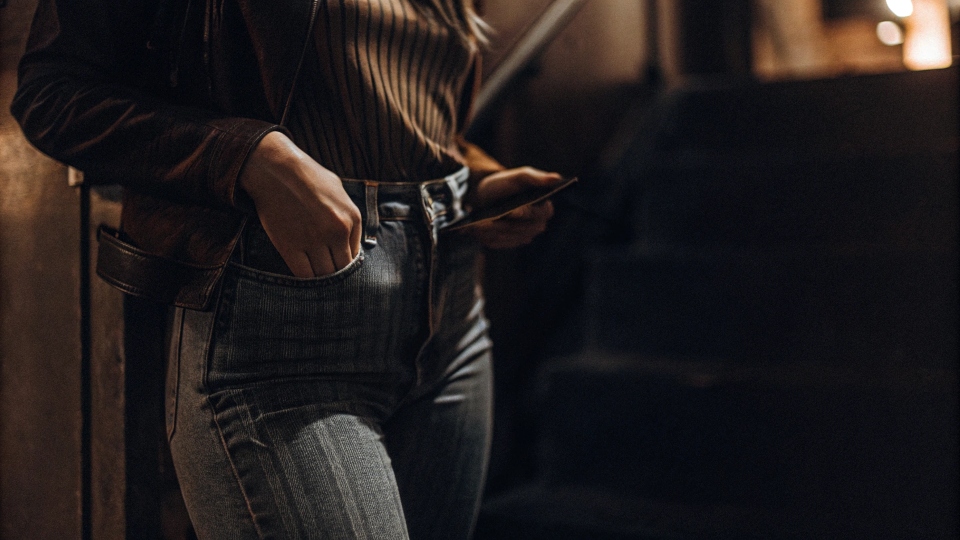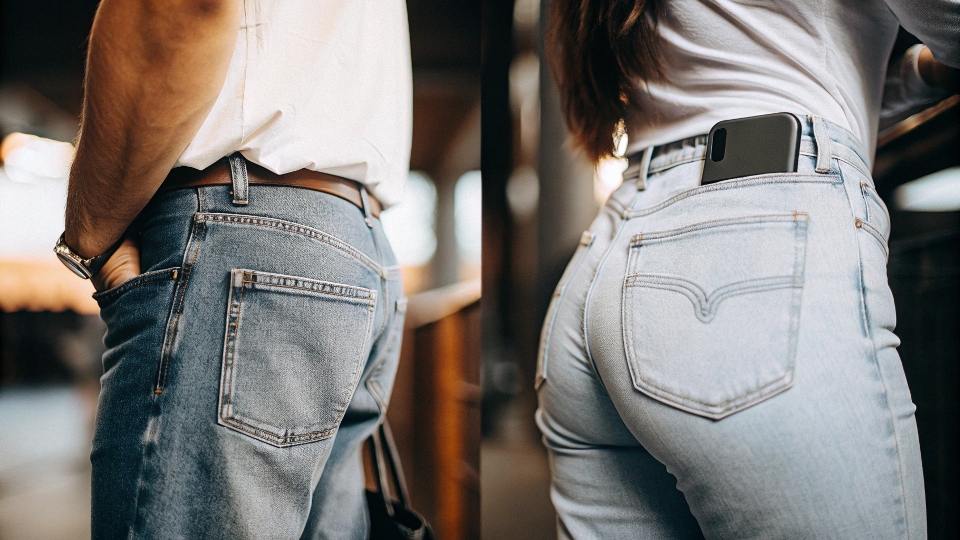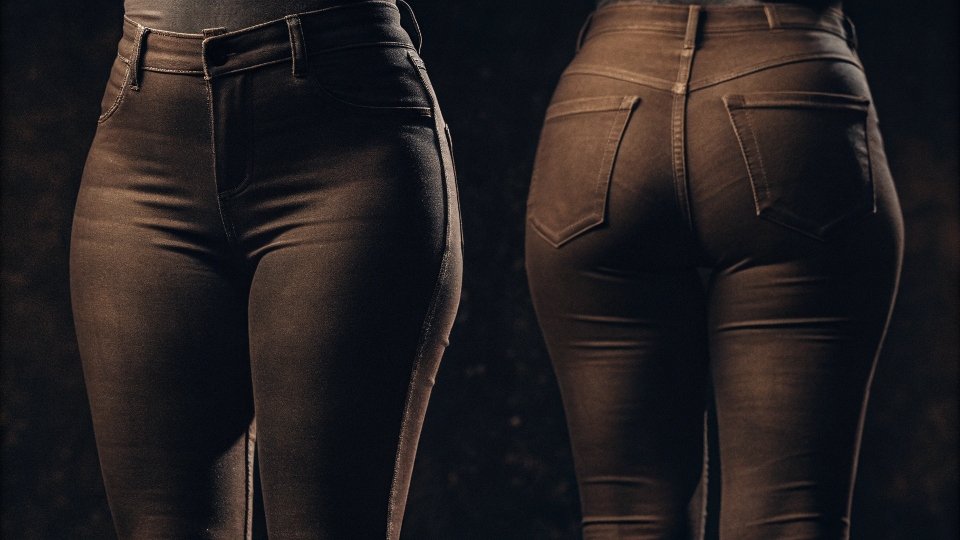You buy a new pair of jeans that look great, but then you discover the front pockets are fake. Or, they're so ridiculously shallow that they’re completely useless. You just want a place to put your phone.
Women’s jeans often have small or fake front pockets1 because fashion has long prioritized a slim, smooth silhouette over practicality. Pockets add bulk to the hip area, so designers shrink them or remove them entirely to create a sleeker look, a trend driven by history and cost-cutting.
In my two decades of running a denim factory, I’ve seen thousands of design specifications come across my desk. The size and shape of a pocket is never an accident; it's a deliberate choice.
These choices are influenced by history, changing fashion trends, and simple production costs. Let's look at exactly why this frustrating feature became so common.
Why do women's jeans not have front pockets?
You see men's jeans with deep, useful pockets and wonder why yours are different. It feels unfair and impractical, forcing you to carry a bag for even the smallest items you need to carry.
Women's jeans often lack deep front pockets because designers have historically tried to avoid adding any bulk to the hip and thigh area. Creating a smooth, unbroken line has been seen as more important than the utility of a functional pocket.
When a designer sends me a tech pack, the pocket specifications are incredibly detailed. For many styles of women's jeans, especially tighter fits, the primary instruction is to keep the front of the garment as flat as possible.
A deep pocket bag, especially with a phone or keys in it, can create a bulge that designers believe ruins the silhouette of the jeans. This idea has its roots in history, when women’s clothing was not designed for utility. Men's jeans were born from workwear, where pockets were essential tools.
Women's jeans were adapted for fashion, and the pockets were often seen as a decorative element rather than a functional one. This priority is clear in the manufacturing specs I see every day.
| Feature | Typical Men's Jeans Spec | Typical Women's Jeans Spec |
|---|---|---|
| Pocket Bag Depth | 6-7 inches (15-18 cm) | 3-4 inches (7-10 cm) or less |
| Pocket Opening | Wide enough for a full hand | Often narrow and restrictive |
| Primary Purpose | Functional storage | Aesthetic; preserves silhouette |
Why did they get rid of women's pockets?
You might remember older jeans having better pockets. Now they seem to be vanishing, and you want to know why this backward step in functional design happened.
Pockets weren't removed in a single decision. The trend was driven by two major industry shifts: the rise of tight-fitting stretch denim2 and the cost-cutting pressures of fast fashion3. Both of these prioritize a sleek fit and lower costs over utility.
From my factory's point of view, I saw these changes happen on the production line.
First, the fabric changed. When stretch denim became the dominant material for women's jeans, it created a new problem. Stretchy fabric doesn't support a heavy pocket bag in the same way that rigid, 100% cotton denim does.
If you put a heavy smartphone in a deep pocket made of thin, stretchy material, it can sag and distort the fit of the jeans. To prevent this, designers simply made the pockets smaller and less functional.
Second, the business model of fashion changed. For fast-fashion brands producing millions of garments, every scrap of fabric counts. The pocket bag inside a jean is usually made from a cheaper plain cotton, but it's still a material cost.
By reducing the size of the pocket bag by a few inches on every pair of jeans, a large brand can save a significant amount of money over a year. It’s a small change on one pair of jeans, but it adds up to a big saving when you produce at scale.
When did women's pants stop having pockets?
You're trying to figure out when this frustrating trend really took hold. It feels like a modern problem, especially now that everyone needs to carry a smartphone.
The trend of shrinking pockets became very noticeable in the early 2000s with the massive popularity of low-rise and skinny jeans. These styles prioritized a tight, body-hugging fit that left no physical or aesthetic room for functional pockets.
I remember this era very well in my factory. Almost overnight, the orders shifted from classic bootcut styles to ultra-tight, low-rise skinny jeans. For these designs to work, the fabric had to lay perfectly flat against the body.
Any bunching from a pocket bag underneath would have been immediately visible, creating lumps and lines. The decision was purely stylistic. To achieve that iconic super-sleek silhouette, the function of the pocket had to be sacrificed.
The pocket stitching on the outside remained because it's part of the classic "five-pocket jean" look, but the pocket itself became completely decorative.
This was also happening at the same time the fashion accessory market was booming. Brands aren't just selling you jeans; they're also selling you handbags.
By making pockets on clothing less functional, there is a stronger incentive for customers to buy a purse to carry their phone, wallet, and keys. While it may not be a deliberate conspiracy, it's a a business ecosystem where a lack of function in one product can drive sales for another.
Do women's jeans have pockets?
After all this frustration, you might be wondering if it's even possible to find women's jeans with real pockets anymore. You feel like you have to choose between a good fit and basic utility.
Yes, absolutely! The trend is starting to reverse. In response to widespread consumer complaints and demand for more practical clothing, many brands are now offering styles of women's jeans that feature deep, fully functional front pockets.
On my factory floor, I am seeing a clear shift in the types of orders we are receiving. The demand for skinny jeans is still there, but there is a huge increase in looser fits like "mom jeans," "boyfriend jeans4," straight-leg, and utility styles5. These wider silhouettes have plenty of room for real pockets without ruining the line of the garment. Designers are listening to the social media movements like #PocketsForWomen and are responding. The key is knowing what styles to look for.
| Jean Style | Typical Front Pocket Functionality | Why It's Designed That Way |
|---|---|---|
| Skinny Jeans | Shallow or Fake | To maintain a smooth, unbroken silhouette |
| Mom Jeans / Straight-Leg | Deep and Functional | Looser fit easily accommodates pocket space |
| Utility/Carpenter Jeans | Very Deep and Functional | Function is the core principle of the design |
| Jeggings | Almost Always Fake or Printed On | Fabric is too thin to support a real pocket |
As a consumer, you now have more choices than ever. When you shop, look for those specific style names. Don't be afraid to test the pockets in the store. The industry is changing, and functional, practical fashion is making a comeback.
Conclusion
The case of the missing pockets was never a mystery, but a choice based on fashion, history, and cost. Thankfully, brands are listening to what women want, and deep, functional pockets are finally returning to women's jeans.
-
Explore the reasons behind the trend of fake front pockets in women's jeans and how it affects functionality. ↩
-
Find out why tight-fitting stretch denim has become a dominant material and its impact on pocket design. ↩
-
Explore the relationship between fast fashion and the reduction of functional pockets in women's jeans. ↩
-
Explore the pocket functionality in boyfriend jeans and why they are a popular choice. ↩
-
Learn about utility styles in women's jeans and their emphasis on functional pockets. ↩




[^4]](https://diznewjeans.com/wp-content/uploads/2025/10/the-trend-of-shrinking-pockets-became-very-notic.jpg)
[^5]](https://diznewjeans.com/wp-content/uploads/2025/10/yes-absolutely-the-trend-is-starting-to-revers.jpg)




